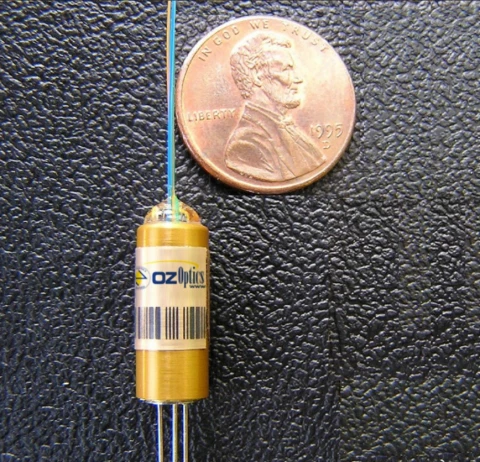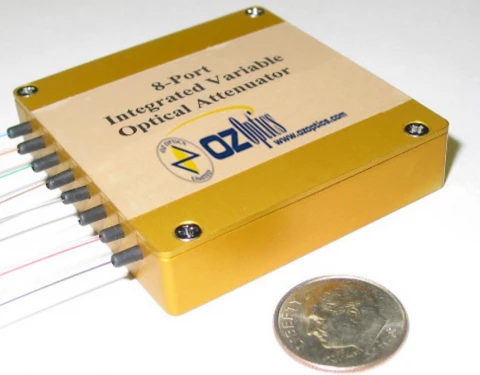Description
The MEMS-based variable optical attenuators (VOAs) offered by OZ Optics are fast, low-cost, and available as single units or arrays. They feature independent continuous attenuation control for each channel, low insertion loss, high dynamic range, and stable and repeatable open-loop operation.
The attenuation is controlled by an analog DC voltage input signal, and they are available with either single-mode or polarization-maintaining (PM) fibers. These VOAs are ideal for signal power management, power balancing, gain equalization, and channel balancing in optical networks.
MEMS Variable Optical Attenuators: Single and Multi-Channel
Specifications
| Number Of Channels: | Single Channel, Multi Channel |
|---|---|
| Operating Wavelength Range: | 780 – 2000 nm |
| Dynamic Attenuation Range (max): | 40 dB |
| Insertion Loss (max): | 0.8 dB |
| Return Loss (min): | 45 dB |
| Number Of Channels: | Single Channel: 1, Multi Channel: 4, 8, … 40 |
| Operating Wavelength Range: | C or L band |
| Dynamic Attenuation Range: | Max. 40 dB |
| Attenuation Without Power: | Normally Closed or Open |
| Attenuation Resolution: | Continuous |
| Insertion Loss: | < 0.8 dB |
| Return Loss: | Min. 45 dB |
| Response Time (Typical) For 6.5 Volt VOA: | 2.0 msec |
| Polarization Dependent Loss (PDL) At 0, 10, 20 DB Attenuation: | Single Channel: 0.10, 0.30, 0.50 dB, Multi Channel: 0.10, 0.30, 0.60 dB |
| Wavelength Dependent Loss (WDL) At 0, 10, 20 DB Attenuation: | 0.20, 0.60, 1.50 dB |
| Temperature Dependent Loss (TDL) At 0, 10 DB Attenuation: | 0.30, 1.10 dB |
| Repeatability (After 100 Cycles): | 0.1 dB |
| Ripple: | 0.2 dB |
| Maximum Optical Power: | 500 mW |
| Polarization Mode Dispersion (PMD): | 0.05 psec |
| Telcordia Spec: | GR-1209, GR-1221 |
| Fiber Type: | SMF 28e + |
| Mechanical Dimensions: | See Drawing |
| Power Consumption: | Single Channel: < 10 mW, Multi Channel: < 10 x n2 mW |
| Driving Voltage: | 0–6.5V or 0–18 V DC |
| Electrical Interface: | Analog |
| Hermeticity (MEMS Only): | < 10-7 atm.cm3/s |
| Operating Temperature Range: | Single Channel: -5 to +70 °C, Multi Channel: -5 to +65 °C |
| Storage Temperature: | - 40 to +85 °C |
Features
- Telcordia GR-1209 and GR-1221 qualified
- Small size and low cost
- Available in single channel and 4 & 8 channel arrays
- Higher port counts up to 40 VOAs per module
- Normally open or normally closed configuration
- Low voltage (6.5 V) or high voltage (18 V)
- Single mode or PM fiber options
- Analog DC voltage control
- Independent continuous attenuation control for each channel
- Fast response and low insertion loss
- High dynamic range and low WDL, PDL, TDL
- Very low power consumption and crosstalk
- Stable and repeatable in open loop operation
- Best-in-class resistance to shock & vibration
Applications
- Signal power management in optical networks
- Dynamic optical power control and channel equalization in add/drop multiplexers
- Power balancing before modulation and multiplexing
- Active gain equalization in DWDM systems
- Power control into receivers
- Gain tilt control in EDFAs
- Channel balancing for optimizing transmission performance in long-haul and metro networks
- Test equipment
Frequently Asked Questions
What is a MEMS-based variable optical attenuator (VOA)?
A MEMS-based variable optical attenuator (VOA) is a device that can control the amount of light passing through an optical fiber by using a micro-electromechanical system (MEMS) to adjust the attenuation of the signal.
What are the features of OZ Optics' MEMS-based VOAs?
OZ Optics' MEMS-based VOAs are Telcordia GR-1209 and GR-1221 qualified, small in size and low cost, available in single channel and 4 & 8 channel arrays, and have independent continuous attenuation control for each channel. They also have low insertion loss, high dynamic range, and stable and repeatable open-loop operation.
What are the applications of OZ Optics' MEMS-based VOAs?
OZ Optics' MEMS-based VOAs are ideal for signal power management, power balancing, gain equalization, and channel balancing in optical networks. They can also be used for dynamic optical power control and channel equalization in add/drop multiplexers, power balancing before modulation and multiplexing, active gain equalization in DWDM systems, and channel balancing for optimizing transmission performance in long-haul and metro networks.
What is the difference between single-mode and polarization-maintaining (PM) fiber options?
Single-mode fiber is a type of optical fiber that allows only one mode of light to propagate through it, while PM fiber is a type of optical fiber that maintains the polarization of the light signal as it travels through the fiber. The choice between single-mode and PM fiber options depends on the specific application requirements.
What is the voltage input signal required to control the attenuation of OZ Optics' MEMS-based VOAs?
The attenuation of OZ Optics' MEMS-based VOAs is controlled by an analog DC voltage input signal. The voltage input signal can be either low voltage (6.5 V) or high voltage (18 V), depending on the specific application requirements.
Similar Products

MEMS Variable Optical Attenuator
Sichuan Ziguan Photonics Technology co.,Ltd
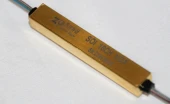
SOI high speed varaible optical attenuator 1/6/48-channel option
Sichuan Ziguan Photonics Technology co.,Ltd

Polarization Maintaining Mechanical Variable Optical Attenuator 1030nm
DK Photonics
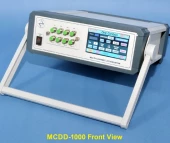
Benchtop Digital Multichannel Attenuator
OZ Optics

Multichannel Electrically Controlled Variable Attenuator
OZ Optics
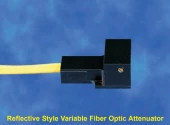
Variable Fiber Optic Attenuator - Reflective Style
OZ Optics
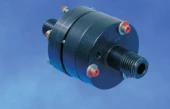
Fixed Neutral Density Attenuators - Expanded Beam Style
OZ Optics

Electrically Controlled Variable Fiber Optic Attenuator
OZ Optics
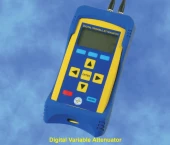
Digital Variable Attenuator
OZ Optics
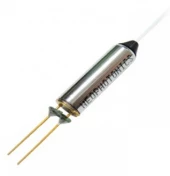
MEMS Variable Attenuator
Pure Photonics
Thank You!
Your inquiry has been received.
Create an account by adding a password
Why create an account?
- Auto-complete inquiry forms
- View and manage all your past messages
- Save products to your favorites
- Close your account anytime — no hassle
